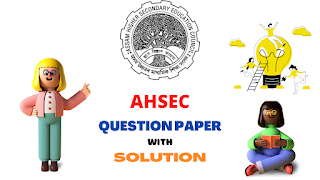AHSEC| CLASS 11| FINANCE| SOLVED PAPER - 2024| H.S. 1ST YEAR
2024
FINANCE
Full Marks: 80
Pass Marks: 24
Time: 3 hours
The figures in the margin indicate
full marks for the questions
1. Answer the following as directed: 1×6=6
(a) The
Banking Regulation Act was passed in the year 1949.
(Fill in the blank)
(b) RRBs were
started in the year 1967/1975/1976. (Choose
the correct answer)
(c) Who is
authorized to issue paper currency in India?
Ans:- The Reserve Bank of India (RBI).
(d) Write the
name of the Central Bank of our country.
Ans:- The Reserve Bank of India (RBI).
(e) Write the
full form of NABARD.
Ans:- National
Bank for Agriculture and Rural Development.
(f) EXIM bank
was established in the year 1982. (Fill
in the blank)
2. What is savings bank? 2
Ans:- A savings bank is a type of financial
institution that focuses primarily on accepting deposits and providing interest
on those deposits. It operates under specific state laws that govern how it
invests money and conducts business. Savings banks are designed to encourage
savings and provide a safe place for individuals to deposit their money while
earning interest.
3. Name any two public sector banks in India. 2
Ans:- There are two public sector banks in India:-
(i) State Bank
of India (SBI)
(ii) Punjab
National Bank (PNB).
4. Write two functions of regional rural banks. 2
Ans:- The two functions of Regional Rural Banks (RRBs)
are:-
(i)
Disbursement of wages: RRBs help in disbursing wages for schemes like
MGNREGA.
(ii)
Providing banking support: They provide banking services in rural and semi-urban
areas, supporting local economic activities.
5. What is bank passbook? 2
Ans:- A bank passbook is a document provided by a
bank to its customers, containing details of all transactions relating to their
account, including deposits, withdrawals and interest earned. It serves as a
record of account activity and balance over time.
6. State any two differences between Commercial Bank and
Reserve Bank. 2
Ans:- There are two differences between commercial banks
and Reserve Bank:-
(i)
Functions: Commercial banks accept deposits, give loans and provide various
financial services to individuals and businesses. On the other hand, the
Reserve Bank of India (RBI) is the central bank responsible for regulating the
country's monetary policy and banking system.
(ii) Role in
the economy: Commercial banks play a role in mobilising public funds and
facilitating economic activities at the micro level. The RBI plays a
macroeconomic role by controlling inflation, managing foreign exchange, and
maintaining financial stability.
7. State briefly the difficulties of barter system.3
Ans:- There are several difficulties in the barter
system:-
(i) Lack of
double coincidence of wants: Both parties must have what the other needs
and be willing to trade, which is often difficult to achieve.
(ii) Lack of
a common standard of value: There is no standard unit to measure the value
of commodities, making the exchange ratio arbitrary.
(iii) Lack of
subdivision: Some commodities cannot be divided without losing value,
thereby limiting trade options.
8 Explain about retail banking.3
Ans:- Retail banking refers to providing banking
services to individual consumers rather than corporate clients.
It includes
the following services:-
(i) Checking
and savings accounts: Basic deposit accounts for managing personal
finances.
(ii) Credit
cards and loans: Personal loans, credit cards, and mortgages for individual
use.
(iii) ATMs
and online services: Convenient access to banking services through ATMs and
online platforms.
Retail banking
focuses on meeting the financial needs of individuals and families.
9. Give the meaning of credit card.3
Ans:- A credit card is a type of loan that allows
users to borrow money from the card issuer to make purchases, pay bills, or
obtain cash advances. It needs to be repaid, often with interest if not paid in
full by the due date. Credit cards offer convenience and flexibility in
managing personal finances, but they can also lead to debt if not used
responsibly.
10. Write a note on trade cycle. 3
Ans:- The business cycle, also known as the business
cycle, refers to fluctuations in economic activity over time, typically
involving phases of expansion, peak, contraction, and trough. These phases are
characterized by changes in GDP, employment, and inflation rates. The cycle is
influenced by factors such as consumer spending, investment, and government
policies. Understanding the business cycle helps policymakers manage economic
stability and growth.
Phases of
Business Cycle:-
(i)
Expansion: Economic growth, increase in output and employment.
(ii) Peak: Maximum
economic activity before recession.
(iii)
Contraction: Economic decline, low output and employment.
(iv) Lowest
point: Lowest point of economic activity before recovery begins.
11. What are the advantages of Internet banking? 3
(Buy E-Books to read complete solutions)
DOWNLOAD [PAGE LINK:-CLICK HERE]
***
FINANCE SOLVED PAPERS PAGE LINK - Click here
BUY E-BOOK (PDF FILE)
[TO SEE FULL SOLUTION]
(Chapter wise Notes, Exam Question Papers solved, MCQ solved) [ARTS, COMMERCE, SCIENCE]
|
DOWNLOAD PAGE LINK:-CLICK HERE |
AHSEC PAGE LINK - CLICK HERE
Also Read:

